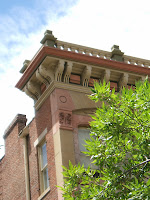




Along the 207-mile journey from Provo, UT to Moab, UT, I came across the small mining town of Helper, UT. Initially what attracted me to the town was the road sign directing me to the Western Mining and Railroad Museum in Helper. Throughout our travels in this area of the country, history is filled with mining and railroad stories and there was never an opportunity to stop and dwell on the subject.
I pulled into Helper and per my usual routine of keeping my gas tank full in this area of great distances between stations; I filled up and then got into conversation with a couple motorcycling in the area. As we exchanged pleasantries, a local fellow joined us on his trike.
Billy quickly began to explain the area and its relationship to mining interwoven with his and his family’s involvement with coal mining in Helper. As we talked, I mentioned that I was interested in ghost towns and he said, “ If you are interested, I can show you one about 5 miles up a local canyon where my grandfather worked and lived.”
I jumped at the chance and as soon as he had finished his coffee we headed up a winding canyon road. His trike was very quick and he soon left me behind enjoying the canyon scenery. We arrived at the town site and he showed me where his grandfather had built his house. Next he pointed out a dark coal seam in the rock high above. A rusted steel mine structure showed where the ore was moved out of the mountain. His conversation continued showing me a rock outcropping where mountain climbers loved to practice their craft.
Then the conversation turned to the difference between a pictograph (a native American painting on the rock) and petro glyph (a carving of figures into the mountain varnish by native Americans). He then invited me to climb up the rock face to a place where both were represented. This was not a national park just a canyon that had been home to Native Americans many years ago. To look on these primitive drawings filled me with wonder. There were no fences or barriers between the drawings and me.
At this point, I began to think of the rest of my journey to Moab and mentioned I wanted to have enough time to see the museum. He thanked me for taking the time and we parted. These impromptu experiences are what make a trip memorable. Traveling on ones own forces conversation with strangers, which many times will develop into a special experience.
I spent a pleasant hour or so at the museum and became familiar with the day-to-day activities of miners and their families in the Helper area. They had their share of mine cave-ins, explosions, labor strife, and the loss of their jobs through the years. A hard life measured by anyone’s standard.





















































